
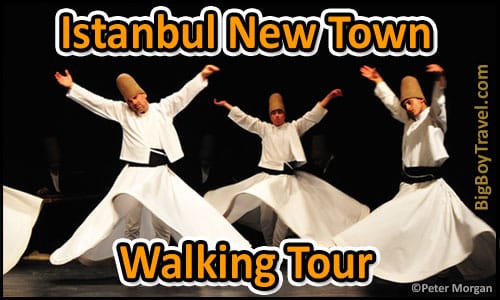
Istanbul New Town Walking Tour:
Location: New Town Istanbul (Beyoğlu & Karaköy)
Cost: Free, Self-Guided (Museum and sight costs below)
Start: Galata Bridge (Galata Koprusu)
End: Karakoy Fish Market (Karakoy Balikcilar)
Distance: 1/2 Mile of Walking (1 1/2 miles of tram riding)
Time: 1 Hours of Walking (with attractions around 4 hours)
Fun Scale: 8 out of 10
To get a different perspective on Istanbul make sure to visit the vibrant New Town neighborhood. Our easy to following walking tour will lead you by beautiful palaces, grand shopping avenues, and bustling back streets. In many ways New Town has become somewhat of the hip soul of Istanbul. Taskim Square has long been the center for peaceful demonstrations and the neighborhood is seems to have a life of its own. We love touring the opulent Dolmabahce Palace which leans heavy on the Rocco style. After visiting the Palace, there are a ton of other great sights to visit along Independence Avenue and French Street. Hope you enjoy our New Town Istanbul walking tour!
New Town Istanbul Walking Tour Sights:
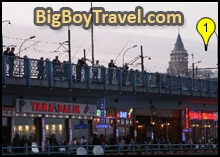
1. Galata Bridge (Galata Koprusu): The energetic Galata Bridge is the perfect segway connecting Istanbul’s historic Old Town and modern New Town to the North. The two-tiered bridge is always peppered with pedestrians and forever full of life. Local fisherman line the rails of the upper level trying to snag a bit with their poles and countless restaurants and shops await your business down below. We love the atmosphere of the areas surround the bridge no matter what time of day and the water side restaurants on Galata’s lower level are charming after dark.
In the days of Constantinople, the Byzantines strung a giant adjustable chain across the Golden Horn roughly where the Galata Bridge is today to stop unwanted ships from coming in from the Bosporus River. Many groups tried to bust through the chain but it wasn’t until the Ottoman conquest of 1453 that anyone did. The Ottomans debated building a permanent bridge where the chain had been many times but for hundreds of years it never got to be anything more then a group of barges tied together. Leonardo da Vinci was even brought to Istanbul and submitted a potential bridge design which was turned down by the Sultan. When the Sultan asked Michelangelo to submit a plan after that he said no. Finally in the mid-1800’s the Ottomans started building a series of wooden bridges up and down the Golden Horn, some even had varying levels of tolls. In the early 2000’s they replaced the last of the wooden bridges with concrete ones including the current Galata Bridge.
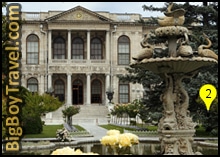
*From the Southeast corner of Galata Bridge jump on the T1 tram line at the Eminönü stop and North to the Kabataş stop. Alternatively you can jump on Tram T1 at any of its stops. The Kabataş stop is as far North as Tram Line T1 goes and only a 400 meter walk away from…
2a. Dolmabahçe Palace: In the late 1800’s a series of lazy and incompetent Sultans had started to push the Ottoman Empire into decline so Sultan Abdülmecid I, the Empire’s 31st Sultan, decided to build Dolmabahçe Palace in an effort to get the Empire’s mojo back. The Sultan thought the prior Palace was too oriental and felt they needed one more in the image of the Rocco palaces of Austria and France. It took the Sultan from 1843 to 1853 to complete, but when he was finished the result was a Palace any royal monarch would be happy to call home.
In all the Palace covers 11.2 acres, has 285 rooms, 46 halls, 6 baths (hamams) and 68 toilets. Although cool, it was kind of a weird place to build a palace as it was largely part of a bay on the river which needed to be filled in, but that’s how the Palace got its name Dolmabahçe meaning Filled Up Garden. Dolmabahçe became the 3rd official governing Palace of the Ottomans with the 1st at today’s Istanbul University, the 2nd at Topkapi Palace, and from 1887 to 1909 there was even a briefly a 4th at the neighboring Yıldız Palace just to the North. In the end, the building of Dolmabahçe Palace didn’t help the fate of the Empire as only 6 Sultan’s got to live here before the Ottomans were thrown out of power in 1922. When the modern government of Turkey took over 1924 they quickly turned Dolmabahçe Palace into a museum.
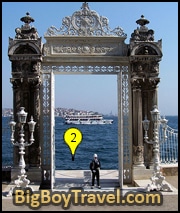
Photo: Darwinek
Guided Tours: The only way to enter the Palace Grounds is to buy tickets for a guided tour. Guided tours of the Palace interior start about every 25 minutes in both Turkish and English and visit both the Selamlık and the Harem. You’re free to roam the ground of your tour until 5pm. Tour Hours: Tuesday, Wednesday, & Friday-Sunday 9am-4pm, closes at 3pm from late October-March; Closed Mondays & Thursdays. Don’t chance it by getting there late as their is a 3,000 visitor a day limit which sells out before close in the busy season. Tour Cost: Selamlık Tour is 30TL, Harem Tour is 20TL, Combo ticket for both is 40TL. We suggest only getting the Selamlık ticket.
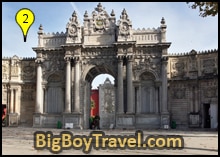
2b. Palace’s Outer Grounds: On the outer edge of the grounds is the unique Palace Mosque (mescit). Though not very big, it sets itself apart from other mosques that have low hanging dull lights, with a giant 4,400 pound crystal chandelier right in its center. As you get closer to the main Palace buildings you run smack into the impressive Treasury Gate (Hazine Kapisi) which is also where the ticket booth is. You will need to buy a ticket to venture further. If you are visiting in the Summer you get an extra treat as at the top of every hour the Palace does a Changing of the Guard near the ticket booth 7 days a week. On Tuesday afternoons their are often free Janissary Band performances near the Treasury Gate of the Palace. If you aren’t there on a Summer Tuesday you may be able to see the band perform the the Military Museum detailed later on this tour or at Topkapi Palace in our Old Town Istanbul Walking Tour.
Once inside the Palace grounds there is an abundance of gardens and near where the tour guides meet, the really cool Imperial Gate. The only real purpose of this gate was because the Sultan was too cool to use the same door as common visitors and guests. If you don’t do it before hand going inside, make sure to check out the imperial boat landing behind the Palace. The royal ship gates are awesome and resemble doors to nowhere framing the river behind them. Usually at least one of the gates will have a guard posted at it, but each of them are fun to take photos at. 360 degree photos: (Gate of the Treasury | the Gate at night | Palace Mosque).
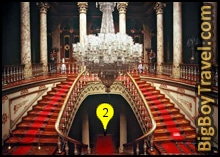
2c. Palace’s Selamlik Wing: (45 minute Tour): If you only have time for one wing of the Palace make sure it is the Selamlık (also known as Mabeyn-i Humayun) where the Sultan would host events, high profile guests, and state affair meetings. The tour gets really impressive about halfway through when you head upstairs by way of the double horseshoe Crystal Staircase, which is our favorite photo opt in the Palace. The staircase isn’t named for the giant chandelier but instead for the rows of Baccarat crystal balusters holding up the mahogany railing. You’ll often see locals getting their wedding pictures on the stairs for the beauty an natural light beaming in from skylights above.
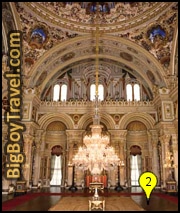
Once upstairs you’re taken to the spacious Ambassador’s Hall (Süfera Salonu) which feels like a unique blend of European ballroom and medieval banquet room. You’ll first be drawn to the gold plated ceiling and crystal chandelier but it is the room’s 950 square foot Iranian rug that is by far the most impressive. Knowing the actual size of the massive rug really helps to put perspective on how large Ambassador’s Hall really is. Of course the Sultan had to have a clock from Egypt made out of silver to show off his power to his guests. The clock still keeps actuate time but surprisingly also the date, air pressure and temperature which was pretty impressive for its day. The Sultan seemed to be obsessed with symmetry with matching 10 foot tall mirrors the back walls, beautiful European crystal street lamps on all 4 corners of the room, and two 150-year-old bearskin rugs up front.
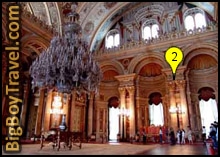
Continuing from Ambassador’s Hall you’ll be lead through many other beautiful such as the Dining Room (Privy Chamber), and the Sultan’s Egyptian Alabaster Bathroom (Hamam), but it is the 21,500 square foot Ceremonial Hall (Muayede Salonu) that’s the most jaw-dropping in the entire Palace. Yes we said 21,500 square feet! Ceremonial Hall, capable of holding 2,500 guests, gets its space from the 118 foot tall and 82 foot wide dome above. With a room so large of course you have to have a 1,330 square foot rug and the World’s biggest chandelier. The 9,000 pound chandelier, built in 1853, was a gift from Queen Victoria, and contains almost 700 bulbs! The Hall is so grand that in 1924 President Atatürk, of the newly formed Turkish Government, gave his first address to the the Turkish people from here. The hall, which is the end of the Selamlık tour, is also where President Atatürk’s coffin was put on public display after his death in 1938.
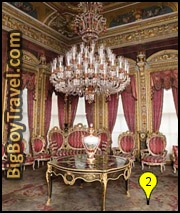
2d. Palace’s Harem Wing (30 Minute Tour): Dolmabahçe’s Harem may not be on the same grand level as the Palace’s Selamlık wing and definitely no where as cool as the historic Harem at Topkapi Palace, but it is still worth a peek if you have time to spare. The Harem was the most private area of the Palace, Harem means forbidden in Arabic, is where the Sultan lived with his Queen Mother (Sultan’s mom), Wives (he could have up to 4), Concubines (female slaves not sexually active with the Sultan), Favorites (girlfriends) Black Eunuch Guards (with genitals cut off) and children. The main purpose of the extra wives and girlfriends was to provide heirs to the Ottoman throne. The Queen Mother restricted all aspects of which women the Sultan could have relations or socialize with and she ran a pretty tight ship.
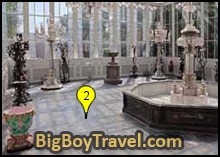
As you enter the Harem and go up Caliph’s Staircase, notice how it has one of the only chandeliers in the Palace with colored crystals. Continuing on you enter the Blue Salon which is basically smaller and blue version of the Ambassador’s Hall in the Selamlık Wing. Notice the blue details in the rugs, furniture fabric, poetry and even the drapery. We love the mural painted ceiling with golden trim. If you like the Blue Salon you’ll be happy to know it has a exact replica sister room coming up with pink accents instead of blue fittingly called the Pink Salon.
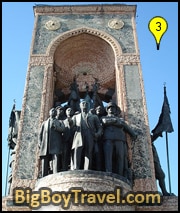
*After checking out the Palace walk back South to the Kabataş Tram/Ferry stop where for 50TL you’ll catch the underground F1 Funicular up the hill to…
3. Taksim Square: In the center of the large square lied the historic Republic Memorial (Cumhuriyet Aniti) which was commissioned to mark the formation of the modern Turkish government. The Memorial lies in the middle of the huge roundabout that takes up most of the Square and shows both sides of Turkey’s 1st President, Mustafa Kemal Atatürk. On one side of the large statue it shows the President in military gear leading a group of fighters into the Turkish War of Independence of 1920. The other side of the statue shows the President in normal dress leading farmers, workers, and commoners to show his statesman of the people side.
Taksimoda Cafe in the Taxim Hotel is a great place to take a break with its floor to ceiling windows facing the square which are open in the summer.
From Taksim Square bus #87 gets you to Chora Church (Kariye Muzesi), known for its amazing mosaics, for about 15TL. Chora Church is open Thursday-Tuesday 9am-5pm, but stays open until 7pm in the Summer. Most people take the bus from Eminönü Square instead which is in our Bazaars Walking Tour.
*If you time your visit right, North of Taksim Square you can watch the family friendly…
4. Ottoman Military Band (Mehter): If you are able to time your visit to New Town just right you’ll be able to catch a traditional Ottoman Military Band (Mehter) at the Military Museum Wednesday-Sunday at both 3pm & 4pm. To many tourist the bands are called Janissary Bands after the musicians to make up the core of the Band itself. No one comes to see the flag guys, just the musicians so the name has stuck. When the bands first formed over 1,000 years ago they were the first military bands in the World. It’s said that they would march ahead of the army through new conquered cities as a show of victory. Sounds kind of like rubbing it in to us, but it was a unique show of power.

The bands are mainly made up by kettledrums called nakare (invented by the Mehter), cymbals called zil (also invented in Turkey), trumpets called boru, oboes (which aren’t very intimidating), bells, and lots of guys with mustaches in colorful dresses. The 20 minutes performances are a little corny but create great photos opts and are family friendly. If you don’t time it right to make a show here it’s okay as in the Summer you can also catch them on Tuesday afternoons inside Dolmabahçe Palace and Wednesday-Monday at 2:30pm inside Topkapi Palace. If you are only looking for the photo opt you are bound to seem many local performers roaming the streets of Istanbul dressed like the Mehter during a couple day visit.
The Military Museum the Mehter mainly play at is pretty blah and can be skipped. History buffs will like how its 22 rooms cover 1,000 years with over 9,000 artifacts, but we find it a little dull and out of the way especially if you aren’t seeing the band. Cost: Free. Performance Times: 20 minute performances every Wednesday-Sunday at both 3pm & 4pm. They bands schedule is subject to change and multiple bands will play through the city during Summer months.
5. İstiklal Caddesi (Independence Avenue): The youthful heart of the Beyoğlu neighborhood with shops, restaurants, theaters and the feel of modern Paris. The 1-mile long avenue is very pedestrian friendly, but we love taking the Historic Red Tram for the first half mile. In 1869 the city opened the tram line to connect Taksim Square to the North with the Tünel Funicular to the South, a feat previously done by horse and carriage. The tram was very popular, but when Istanbul stopped running all of their trams in 1960, it took 30 years before this popular route was re-opened.
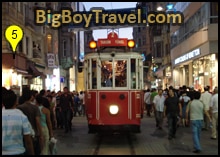
As you glide along notice how strong of a European feeling the avenue has. This feel comes not melting pot of European immigrants who grew the neighborhood over time, but also from the great Pera fire of 1870 which destroyed many buildings. The destruction from the fire let locals rebuild many local buildings in the image of popular Rues in Paris. They even gave it a European name and called it Grande Rue de Pera.
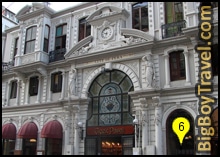
6. Flower Passage (Çiçek Pasaji): The 1920s-1940s were considered the peak of the Grande Rue de Pera and brought to it many great shops including a huge amount of flower shops. The greatest concentration of flower shops congregated inside first floor of the the Cite de Pera building. The first floor flower shops become so renown that the floor was called the Flower Passage. The Flower Passage thrived until the roof collapsed in 1978 forcing most of the flower shops out. While only a shell of its former self, the main hall on the of Cite de Pera is definitely worth a quick peak and still impressive and filled with numerous slightly expensive restaurants. The Avropa Pasaj shops near Cite de Pera are still favorite of locals today. 360 degree photos: (Inside the Flower Passage | Avropa Pasaj Shops).
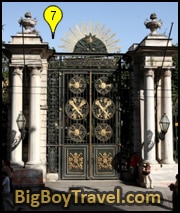
7. Galatasaray Lisesi Gates: Gilded Gates of the Galatasaray Lisesi School which was established in 1481. The outside areas of the school grounds are typically open to the public daily from 9am-5pm, but most people just hang out and take pictures are the massive front gates. Galatasaray Square just South of the Gates is a common meeting place for friends taking strolls down Istikal to shop. We love how modern the Square feels and it’s almost like you are in the middle of modern London.
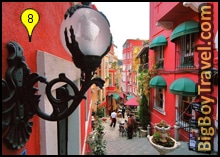
8. French Street (Fransız Sokağı): We highly suggest a detour directly behind Galatasaray Lisesi School to the pedestrian only French Street (Fransız Sokağı). French Street, listed as Cezayir Sokağı on some maps, is renown for great pubs & lively restaurants. We love getting an outdoor table for lunch of popping in for an evening drink, it’s very inviting. French Street turns to steps as you continue downward but photographers will be rewarded for descending the alleyway as the colors and perspective get better and better. It’s all so nostalgic, but French didn’t exist like this until 2004 when the area got a total facelift. The atmosphere always gives us fuzzy feelings as they has light background music playing on speakers all over, art galleries, street musicians, romantic gas lamps after dark, and how can you been beat outdoor seating on bright fabric couches. 360 degree photos: (#1, #2 | #3 | #4).
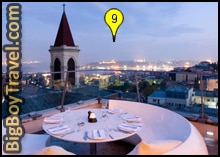
9. Egypt Apartments (Misir Apartmani): The 8 story white apartment building was the start of a modern facelift in the Beyoğlu when it was built in 1920. There are often open artist galleries throughout but the coolest thing is the 360 Club (website) on the roof. As one of the neighborhood best nightclubs, the 360 club overs great 360 degree views of the city and also a great lunch menu if you looking for a bite with a view. We actually prefer the views from the 360 Club of the views from the imposing Galata Tower nearby as it gives you the chance to take pictures with the tower in the background. The apartments are called the Egypt Apartments because they were once where Halim Pasha, the son of an Egyptian prince, lived in the Winter. Address: Istiklal Street #163
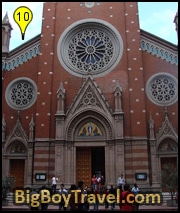
10. St. Anthony’s Church (St Antoin di Padua): St. Anthony’s Church sits in a slightly hidden courtyard but you should really make the effort to seek it out. Getting to the charming courtyard is fun as you stroll under a triple-arched gateway which resembles the aqueducts of many ancients cities. On first glance the pink and red stripes of brick around the base of the will be first to catch your eye, but there are other hidden details out front. Above each door is a beautiful gold mosaic and to the right is a statue of the recognizable Pope John XXIII. The statue commemorated 9 years of service Pope John XXIII gave the Catholic Church of Istanbul from 1935-1944 and even Pope Benedict XVI made it to the unveiling. The interior is a little blah but a slow 360 degree turn taking in the entire courtyard is rewarding. Hours: Daily 8am-7:30pm, Courtyard is open late. 360 degree photo: (Front of the Church).
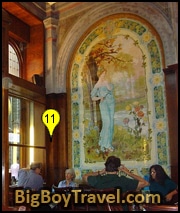
11. Markiz Patisserie: With New Town on the upswing in 1850, the pastry shop Lebon Pastanesi to mimic fancy sweet shops in neighboring countries. The fancy edge was meant to capture the growing wealth of the neighborhood complete with large chandeliers and 4 huge titled panels custom made in Paris to represent each of the four seasons. Although only two of the panels were strong enough to actually make the trip (Spring & Autumn), both still remain today. With Grand Rue de Pera at its peak in 1940, Avedis Çakır, bought the pastry shop and changed the name to Markiz Patisserie which is a name that has stuck with locals until this day even though it now holds a coffee shop franchise. Although the current coffee shop isn’t anything special, definitely stop in a check out Markiz Patisserie’s titled wall panels. Address: İstiklal Avenue No. 172A
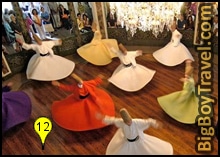
*Continue down to the the end of the tram line at Tünel Station…
12. Whirling Dervish Lodge (Galata Mevlevihanesi): 500 year old lodge of the Whirling Dervishes who preform the traditional Sema ritual popular with tourists. During the ceremony, visitors sit on the outer edge of the modest octagon shaped room while the Dervishes twirl to traditional music. During the twirling the Dervishes seem to be in trance-like state which is said to bring them closer to God. Some performances also incorporate belly dancers to kick the show off. If you aren’t able to make the Sunday evening show, which can be $80 a person, the museum is offers an inside look and Dervish costumes, instruments, and other artifacts. Museum Hours: Wednesday-Monday 9am-4:30pm, closed Tuesdays. Dervish Shows: Every Sunday at 5pm.
13. Galip Dede Caddesi: Still known on some maps as Yüksek Kaldirim which means High Sidewalk. Galip Dede Caddesi has a lot of charm as an old cobbled lane lined with modern and traditional musical-instrument shops. This street gives a great old-world feel as your passage to the Galata Tower. Feel free to pop into any local shop or book dealer along the way.
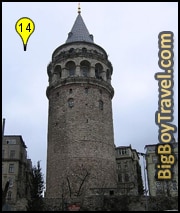
14. Galata Tower: The Byzantine Empire originally built a wooden tower here in 507 that they called the Great Tower (Megalos Pyrgos). Then in 1348 as the Geneose people expanded the neighborhood they rebuilt it as the current stone tower and called it Tower of Christ (Christea Turris). When the Ottomans conquered the city in 1453 they turned the tower in dungeon for over 100 years before using it as a fire tower. Local legend says that in the 16th Century Hezarfen Ahmet Celebi became the first man to fly when strapped wooden wings to his arms and jumped off the tower.
If you happen to do this tour in reverse, you can either take a 15 minute walk uphill to the tower or use the Tunel Funicular which only takes 90 seconds. The Tunel is really cheap and is the 3rd oldest metro line in the World. Tower Hours: Daily 9am-8pm. Cost: 10TL. Kafkas Shows: Run each evening run inside the Tower from 8pm-Midnight and feature a great dinner, drinks, traditional dancers, belly dancers, and knife throwers. For reservations it’s easy to email them at info@galatatower.net. Cost for the show is around 55 Euros. 360 degree photo: (The square out front | View from the top).
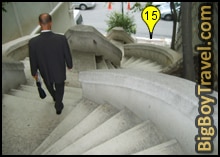
15. Camondo Staircase (Kamondo Merdivenleri): Leading the way down the hill from New Town above, the Camondo Staircase was a fitting passage to the bankers going to work on Bankalar Sokagi (Bank Street). This decant twisting staircase case is a master piece of architect many Avram Camondo who built many structures along Bank Street.
16. Karaköy Fish Market (Karaköy Balikcilar): The Karaköy Fish Market isn’t so much an actual market as it is a collect of tents that will both sell and fry up fresh caught fish for you. The Market goes back to the Byzantine days when Jewish settlers first moved to area North of old town Istanbul and called the neighborhood Karaköy. The Market is still a favorite spot among locals and a great place to get a cheap bit to eat. You can get a fish filet sandwich in fresh bread and a soda typically for about 20TL. During busy times for the day some fishmongers may pre-cook sandwiches to get a head of the rush so keep an eye to make sure you are getting a fresh one. Some stand are as fresh as you can get as they actually filet the fish in front of you before cooking it. If you have the option to pick your fish, get the one with the most red gills at it is the sign that is came out of the water most recent. It’s a step outside the normal but you’ll be able to tell your friends you went to Istanbul and got served up by a fishmonger!
Other Sights Near New Town Istanbul:
Modern Art Museum
Nusretiye Mosque – Located right next to the Modern Art Museum. Very hip nargile experience, try the numerous beanbag-decked cafés that cluster together off Tophane Iskelesi
Yeralti Camii – underground mosque in New Town near the Baths
Sarabi Wine Bar – upper New Town inside an aqueduct from the 1800s




